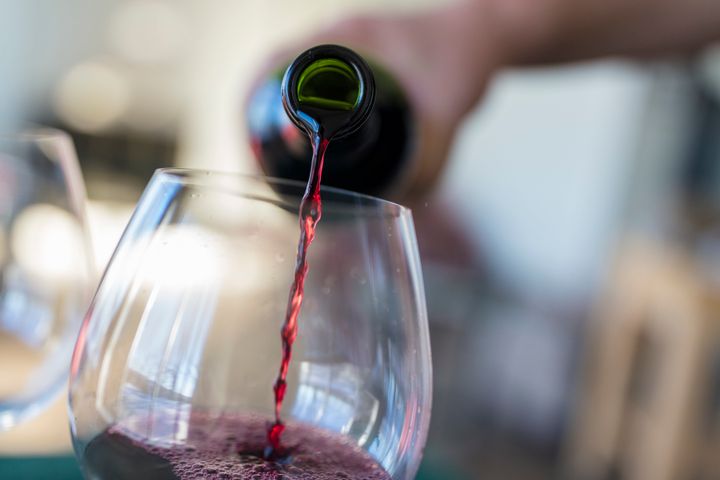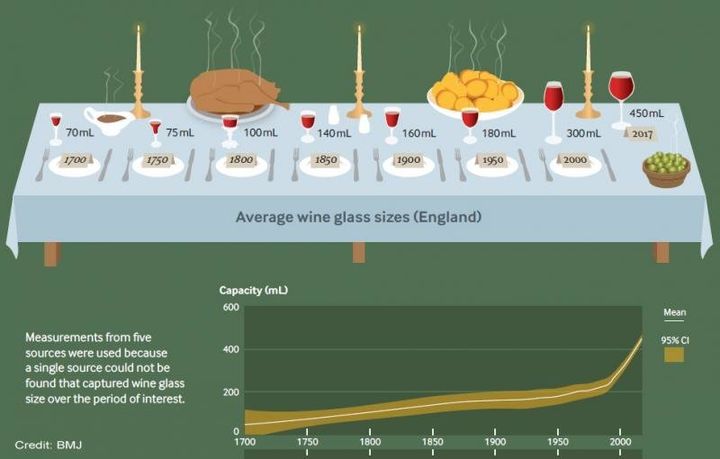It’s not unheard of to go to a nice restaurant and be greeted with a wine glass that’s almost as big as your face. But while it’s often a welcome sight for wine-drinkers, it might not be great news for health.
A new study published in the BMJ details how wine glass sizes have almost doubled in size since the 1990s alone, which strongly correlates with an increase in the amount of alcohol we drink.
Alcohol is the fifth largest risk factor for early death and disability in high income countries, and seventh largest worldwide.

Researchers at the University of Cambridge studied changes in wine glass size over time and found that the capacity of wine glasses in England increased from an average of 66ml in 1700 to 449ml in 2017 - an almost sevenfold increase
Alcohol consumption, and wine consumption in particular, have increased sharply since the 1960s - reflecting greater affordability, availability, and marketing of alcoholic products, as well as more liberal licensing.
Larger tableware is known to increase food consumption, but less is known about glassware’s relation to how much we drink. So, Theresa Marteau and colleagues from the University of Cambridge’s Institute of Public Health set out to investigate whether changes in wine glass size over time might have contributed to the steep rise in wine drinking in the past few decades, and whether reducing wine glass size may help cut consumption.
They searched online and contacted experts in antique glassware, eventually gathering measurements for 411 glasses from five sources in England, dating from 1700 to 2017.

Results showed that the capacity of wine glasses in England increased significantly over the past 300 years, with a marked increase since the 1990s.
In the past 25 years alone, the average wine glass has gone from 232ml (1990-93) to 449ml (2016-17).
The researchers point to possible reasons for the increase in glass size since 1990. For example, demand for larger wine glasses by the US market was met by an increase in the size of glasses manufactured in England, and size was influenced by those running bars and restaurants, who sought to increase sales of wine.
The authors say they cannot infer that the increase in glass size is a direct cause of the rise in wine consumption in England, nor that reducing wine glass size would cut drinking. But they suggest that along with lower prices, increased availability and marketing, “larger wine glasses may have contributed to this rise through several potentially co-occurring mechanisms”.
In the response to the research, Dr James Nicholls, director of research and policy development at Alcohol Concern, told HuffPost UK: “By far the biggest change in British drinking culture over the last 50 years has been the huge rise in wine drinking.
“Until the 1970s, wine was largely a drink of social elites. Not only were wine glasses smaller, but few people regularly used them. We drank most of our alcohol as beer in the pub, now we drink much of it as wine at home.
“Wine consumption has increased enormously while beer sales have halved. Wine has also become stronger and glass sizes larger: I don’t think many of us realise that a 250ml glass of 14% wine contains over 3 units of alcohol, which is more than a pint of strong beer.
“If you think of a large glass as equivalent to a pint of Stella, then you see how quickly the alcohol content adds up.”
Dr Nicholls said there are many known health repercussions of increased drinking, such as liver disease, high blood pressure and several types of cancer.
To conclude, researchers pointed to several policy options for reducing drinking outside the home as well as influencing the size of glasses people use at home - where most alcohol, including wine, is drunk. These include reducing wine glass sizes in licensed premises, encouraging retailers to price glasses according to size and encouraging wine producers and retailers to make bottles of wine available in smaller sizes, with proportionate pricing.
With Christmas fast-approaching, the researchers (quite rightly) predict that these suggestions will prove more popular with the general public in January rather than in December.